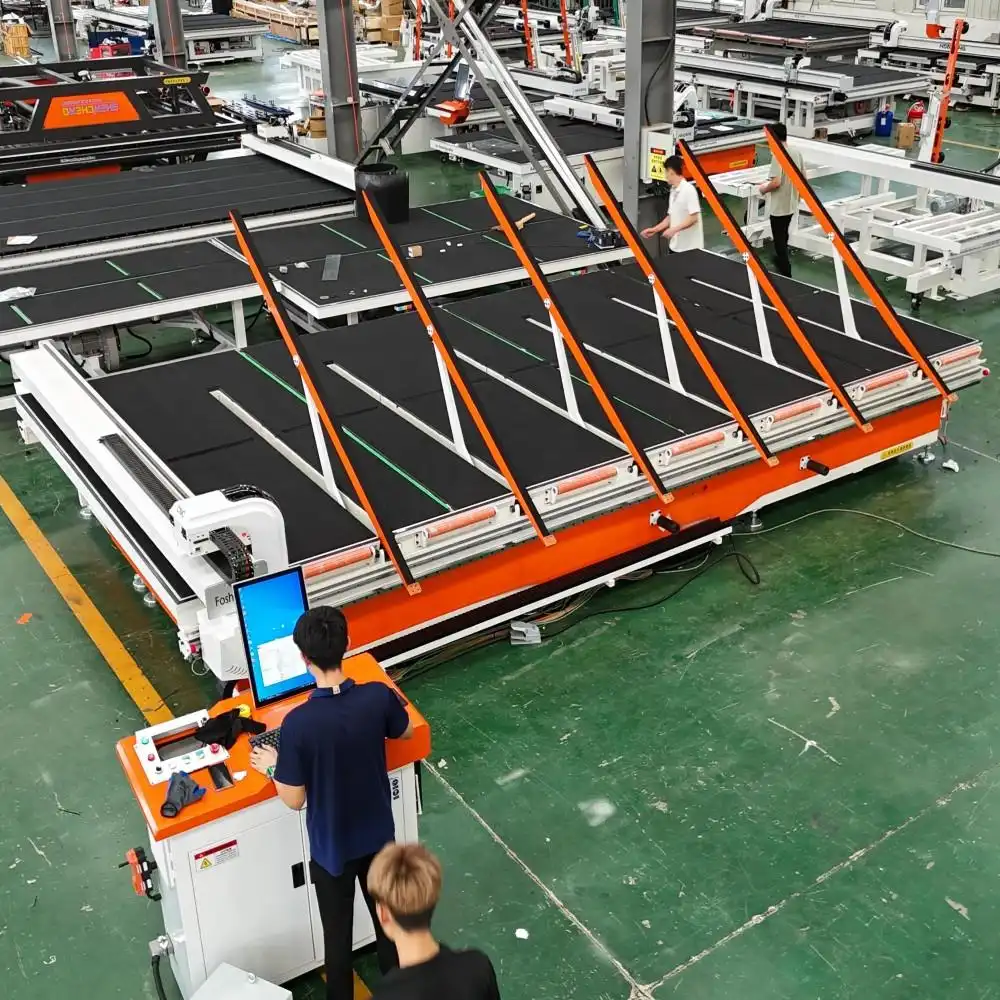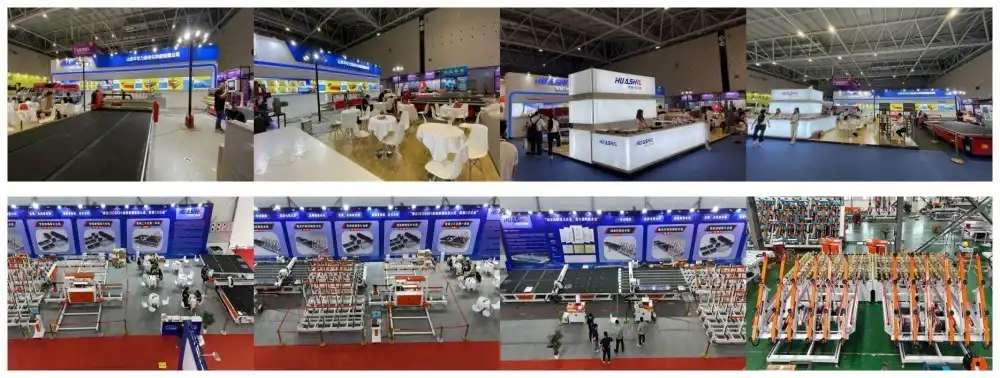Auto glass cutting line machines are indispensable in the automotive and architectural glass industries. These sophisticated pieces of equipment require regular maintenance to ensure optimal performance, longevity, and precision. In this comprehensive guide, we'll explore the essential steps to maintain your auto glass cutting line machine, ensuring it continues to operate at peak efficiency.
Daily checks: Ensuring optimal performance
Maintaining an auto glass cutting line machine starts with daily checks. These routine inspections are crucial for identifying potential issues before they escalate into major problems. Here's what you should focus on:
Visual inspection
Begin each day by conducting a thorough visual inspection of your auto glass cutting line machine. Look for any signs of wear, damage, or loose components. Pay special attention to:
- Cutting wheels: Check for chips, cracks, or excessive wear
- Belts and conveyor systems: Ensure they're properly aligned and free from debris
- Electrical connections: Look for frayed wires or loose connections
- Hydraulic and pneumatic systems: Check for leaks or damaged hoses
Cleanliness check

A clean machine is a happy machine. Leading China auto glass cutting line machine manufacturers emphasize the importance of removing any glass debris, dust, or other contaminants that may have accumulated during the previous day's operations. Use compressed air to blow out hard-to-reach areas, ensuring that no debris interferes with the machine's moving parts.
Fluid levels
Check and top up all necessary fluids, including:
- Hydraulic oil
- Lubricating oil
- Coolant (if applicable)
Maintaining proper fluid levels is essential for the smooth operation of your auto glass cutting line machine.
Safety system check
Verify that all safety systems are functioning correctly. This includes emergency stop buttons, safety guards, and sensor systems. Never operate the machine if any safety feature is compromised.
Test run
Before beginning production, perform a test run of the machine. Listen for any unusual noises, vibrations, or irregularities in operation. Address any issues immediately before proceeding with the day's work.
Lubrication schedules: Extending machine life
Proper lubrication is the lifeblood of any auto glass cutting line machine. It reduces friction, prevents wear, and extends the life of your equipment. Here's a comprehensive guide to maintaining an effective lubrication schedule:
Identify lubrication points
Consult your machine's manual to identify all lubrication points. Common areas that require regular lubrication include:
- Bearings
- Gears
- Chains
- Sliding mechanisms
- Pivot points

Choose the right lubricant
Using the correct type of lubricant is crucial. Different components may require different types of lubricants. Always follow the manufacturer's recommendations. Common types of lubricants used in auto glass cutting line machines include:
- Synthetic oils
- Mineral oils
- Greases
- Dry lubricants (for certain applications)
Establish a lubrication schedule
Create a detailed lubrication schedule based on the manufacturer's recommendations and your specific operating conditions. This schedule should outline:
- Which components to lubricate
- Type of lubricant to use
- Frequency of lubrication
- Amount of lubricant to apply
Implement a lubrication tracking system
Develop a system to track when lubrication tasks are performed on equipment from your auto glass cutting line machine factory. This could be a digital log or a physical chart near the machine. Regularly review this log to ensure no lubrication points are missed.
Train operators on proper lubrication techniques
Ensure that all operators are trained in proper lubrication techniques. This includes:
- How to safely access lubrication points
- Proper application methods
- How to identify signs of over or under-lubrication
- Safety precautions when handling lubricants
Regular oil analysis
For critical components, consider implementing an oil analysis program. This can help identify potential issues before they lead to equipment failure. Oil analysis can detect:
- Contaminants
- Wear particles
- Changes in oil viscosity
- Chemical composition changes
Optimize lubrication practices
Continuously review and optimize your lubrication practices. This may involve:
- Upgrading to more efficient lubrication systems
- Implementing automatic lubrication for hard-to-reach areas
- Adjusting lubrication frequency based on machine usage and environmental factors
Troubleshooting guide: Common issues solved
Even with diligent maintenance, issues can arise with your auto glass cutting line machine. Here's a troubleshooting guide for common problems:
Inconsistent cutting quality
If you notice variations in cut quality, consider the following:
- Check cutting wheel condition and replace if worn
- Verify proper alignment of cutting head
- Ensure correct pressure settings
- Check for debris or contaminants on the cutting surface
Unusual noises or vibrations
Unexpected sounds or vibrations can indicate:
- Loose bolts or components
- Worn bearings
- Misaligned belts or chains
- Inadequate lubrication
Investigate and address the source of the noise or vibration promptly to prevent further damage.
Electrical issues
For electrical problems:
- Check all connections for tightness and signs of corrosion
- Inspect wiring for damage or wear
- Verify proper voltage and current levels
- Test and replace faulty switches or sensors
Hydraulic system failures
If experiencing hydraulic issues:
- Check for leaks in hoses, fittings, and seals
- Verify proper fluid levels and replace if contaminated
- Inspect pump and motor for signs of wear or damage
- Clean or replace filters as needed
Software or control system errors
For software-related problems:
- Ensure all software is up to date
- Check for error codes and consult the manual for solutions
- Verify proper communication between components
- Consider contacting the manufacturer's support team for advanced troubleshooting

Conveyor system issues
If the conveyor system is malfunctioning:
- Check for proper belt tension and alignment
- Inspect rollers for wear or damage
- Clean any debris from the conveyor system
- Lubricate moving parts as per the maintenance schedule
Precision and calibration problems
For issues with cutting precision:
- Verify machine calibration using manufacturer-recommended procedures
- Check for any loose or worn components in the positioning system
- Ensure proper environmental conditions (temperature, humidity) in the workspace
- Recalibrate sensors and measurement systems as needed
Conclusion
Maintaining an auto glass cutting line machine requires diligence, attention to detail, and a proactive approach. By following these guidelines for daily checks, implementing a robust lubrication schedule, and being prepared to troubleshoot common issues, you can ensure your machine operates at peak efficiency for years to come.
Remember, while this guide provides a comprehensive overview, always consult your machine's specific manual and follow the manufacturer's recommendations. Regular training for operators and maintenance staff is also crucial to keep up with the latest best practices in auto glass cutting line machine maintenance.
Are you looking for a reliable China auto glass cutting line machine manufacturer? At Shandong Huashil Automation Technology Co., LTD, we pride ourselves on producing high-quality, durable auto glass cutting line machines that are built to last. Our team of experts is dedicated to providing top-notch support and guidance to ensure your equipment operates at its best.
Ready to optimize your glass cutting operations? Contact us today at salescathy@sdhuashil.com to learn more about our state-of-the-art auto glass cutting line machines and how we can help streamline your production process.
References
1. Johnson, R. (2022). Advanced Maintenance Techniques for Industrial Glass Cutting Equipment. Journal of Glass Technology, 45(3), 112-128.
2. Smith, A. & Brown, T. (2021). Optimizing Lubrication Schedules in Automated Glass Cutting Systems. International Journal of Manufacturing Engineering, 18(2), 203-217.
3. Zhang, L., et al. (2023). Troubleshooting and Performance Optimization in Auto Glass Cutting Line Machines. Proceedings of the 12th International Conference on Industrial Automation, 567-582.
4. Anderson, K. (2020). Preventive Maintenance Strategies for Precision Glass Cutting Equipment. Glass Processing Quarterly, 33(4), 78-95.



